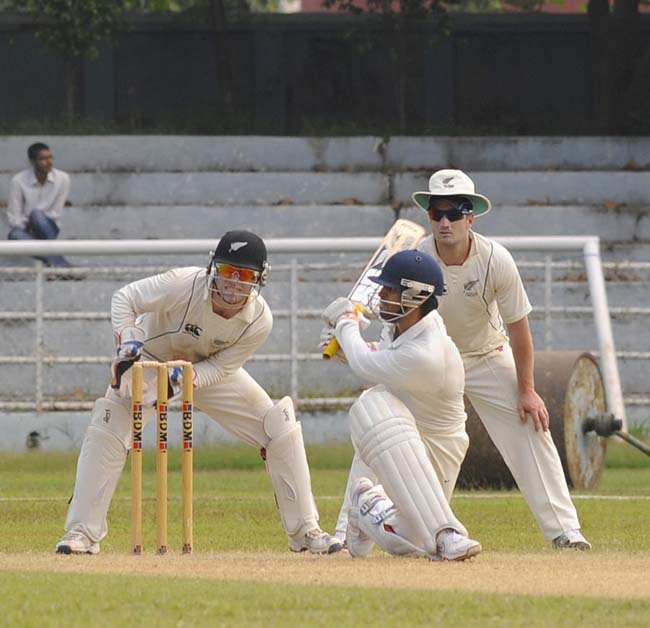Shimoga: At the end of each day’s play, long after the players have left the Jawaharlal Nehru National College of Engineering Ground in Shimoga, around 200 people gather outside the West Indies A pavilion. These are mostly volunteers – only a few of them as college employees are paid extra for this – waiting for their work in the day to be accounted for. One by one, a certain committee’s name is called up on the microphone.
“Sight-screen committee,” you can hear, “today was okay, but in the 27th over, just before lunch, you let a man cross the screen as the bowler was running in. You can get better tomorrow.” There are 18 such committees formed only for these six days. There is a food-for-players committee, there is a food-for-others committee, one committee looks after the police’s needs, and another committee liaises with the BCCI and Karnataka State Cricket Association.
Some of these 200 volunteers are either college students, doctors, board officials or friends. Except for the college workers who have been paid extra to work here, nobody is getting paid. This is only the fourth first-class match the city is holding, and the second for this particular venue. Shimoga isn’t quite the seasoned pro, but it doesn’t want to leave much to chance.
Over the last three days, the committees and the volunteers have been rewarded with healthy crowds, but the actual cricket has fallen prey to a slow and flat pitch. When, at 11.04am on the final morning, Mohammad Kaif flicked one past midwicket, India A had successfully avoided the follow-on. The pitch was not going to break up, and this match was reduced to a glorified net session.
The lower order enjoyed it and batted without pressure or direction. By the time the last India A wicket fell, only 47 runs separated the two teams, and there was only a day and 14 overs left to force a result. India A had no incentive to go for quick runs. West Indies A – missing Fidel Edwards, who bowled just four overs – couldn’t find enough in the pitch to blast their way through the lower order. Nor was there a brilliant innings to watch because of the slowness of the pitch.
At least in Ranji Trophy, the teams still continue to fight for first-innings points. Here the ceasefire was declared after a little over halftime. The only way to get close to a result was a follow-on or some really inept batting. A-team cricket is meant to prepare you for international challenges through simulation, but if it is played on dead pitches, half of it tends to be less intense than a Ranji Trophy match.
The only batsman who managed to dictate on the pitch was Abhishek Nayar, becoming the sixth half-centurion to fail to get to the century. He fell to a reverse-sweep when on 89 off 88. He said the pitch was “difficult to score runs on, though there isn’t much happening there. It’s a slow pitch so I think sometimes having more sporting pitches may give results. But I also felt both teams batted pretty well”.
When Nayar fell, following VA Jagadeesh’s dismissal for 86, India A were 12 short of making West Indies A bat again. That task was duly achieved, and after that everybody sort of went through the motions. Wicketkeeper Uday Kaul managed to stick around for a half-century. Miguel Cummins managed to produce a yorker to consign Zaheer Khan to a golden duck, but the big crowd didn’t have much else to write home about.
Zaheer followed up with an economical five-over spell, but the West Indies A openers saw him off with ease. A pretty innocuous day’s play ended with 87.1 overs producing seven wickets and runs at 2.25 an over. Another such day was in store, but the volunteers still waited for their committee’s name on the microphone.
West Indies A 406 and 28 for 0 (Brathwaite 18*, Powell 9*) lead India A 359 (Nayar 89, Jagadeesh 86, Kaul 64, Cummins 3-58) by 75 runs

